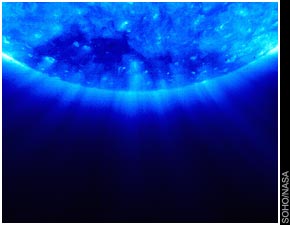Telescopes / Observatories
The Hubble Space Telescope (HST) is a cooperative program of the National Aeronautics and Space Administration (NASA) and the European Space Agency (ESA) to operate a long-lived space-based
observatory for the benefit of the international astronomical community. HST is a 2.4-meter reflecting telescope which was deployed in low-Earth orbit by the crew of the space shuttle
Discovery (STS-31) on 25 April 1990.

The spaced-based x-ray observatory operated for NASA by the Harvard-Smithsonian Astrophysical Obsrvatory. First images of supernovae, galaxies, and galaxy clusters.
Solar and Heliospheric Observatory. Satellite monitoring the sun, providing new clues about our nearest star.

Soon to be the World's largest optical telescope, located in Chile. Part of the European Southern Observatory.
From a remote outpost on the summit of Hawaii's dormant Mauna Kea volcano, astronomers at the W.M. Keck Observatory probe the deepest regions of the Universe with unprecedented
power and precision. The twin Keck Telescopes are the world's largest optical and and infrared telescopes. Each stands eight stories tall and weighs 300 tons, yet operates with
nanometer precision. At the heart of each Keck Telescope is a revolutionary primary mirror. Ten meters in diameter, the mirror is composed of 36 hexagonal segments that work in
concert as a single piece of reflective glass.
Near Pasadena, California.
Japan's 8.2 meter optical-infrared telescope at the summit of Mauna Kea in Hawaii.
The Gemini Project is an international partnership that will result in two 8.1-meter telescopes (each telescope has a main mirror over 26 feet across). One telescope is
located on Hawaii's Mauna Kea, and the other on Chile's Cerro Pachón. The name Gemini comes from the mythological twins, whose stars will be visible to both telescopes.
Optimized for infrared.
The goal of the LBT project is to construct a binocular telescope consisting of two 8.4-meter mirrors on a common mount. This telescope will be equivalent in light-gathering
power to a single 11.8 meter instrument. Because of its binocular arrangement, the telescope will have a resolving power (ultimate image sharpness) corresponding to a 22.8-meter
telescope. Saffard, Arizona.
A multiwavelength observatory designed to map the accretion disks and environments of supermassive black holes in active galactic nuclei and stellar-sized black holes, neutron stars, and white dwarfs in Galactic binary systems.
The James Webb Space Telescope (JWST) is an orbiting infrared observatory that will take the place of the Hubble Space Telescope at the end of this decade. It will study
the Universe at the important but previously unobserved epoch of galaxy formation. It will peer through dust to witness the birth of stars and planetary systems similar to
our own. And using JWST, scientists hope to get a better understanding of the intriguing dark matter problem.


